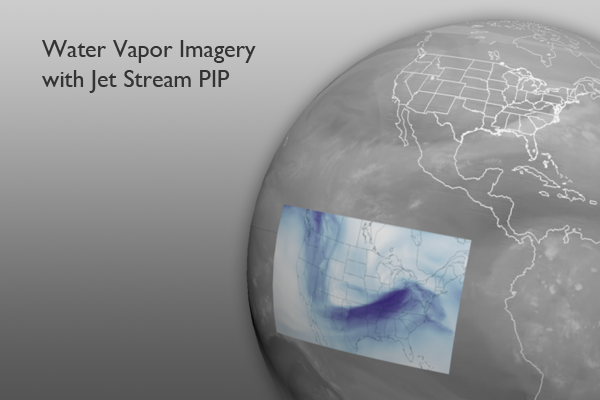About a month ago, a large tornado outbreak devastated parts of the South and Ohio River Valley. Over 120 tornadoes (preliminary numbers) were reported, along with over 500 other severe weather reports, including hail and high winds. Unfortunately, this storm system also resulted in at least 39 fatalities. For this week’s EarthNow post, we’re going to take a closer look at how the storm system evolved and created such destructive and deadly tornadoes.
 Storm System Animation
Storm System Animation
Visualization Description: This first visualization is an animation of IR satellite imagery over a 48-hour period. The animation starts at 6pm CST on March 1, 2012, the day before the massive early-season tornado outbreak. As the animation approaches March 2, the area of interest is highlighted. A clock will also appear and be displayed for the entirety of March 2nd. As the animation progresses, a low pressure “L” symbol will also move across the area of interest from about 7am through 9:30pm CST, the time period that most of the storm activity occurred. Following the low pressure movement, red dots, representing tornado reports, appear along with a gray base map. For SOS veterans, it should be noted that the IR animation will seem particularly slow. I slowed it down a lot to allow time to see the relatively fast moving storm system.
About the Data: It’s possible that the warmer than normal winter in much of the U.S. contributed to this earlier than normal severe weather outbreak. Weather and climate scientists suggest that warmer than normal sea surface temperatures (about 1˚C above normal) across the Gulf of Mexico played a part in fueling the severe weather. As warm moist air moved northward out of the Gulf of Mexico, cold dry air moved southeast out of Canada. You can even see the cold front in the IR satellite imagery, draping southwest from the low pressure symbol.
As the cold dry air at higher altitudes and warm moist air collide, the atmosphere became very unstable. Moist air (and warm air) is less dense than the cold dry air and is therefore forced upward as columns of air into thunderstorms, called updrafts. At this point, we still don’t have tornadoes, however. The air in the storms needs to become “twisted” by something called shear, when the winds at various levels of the atmosphere change speed and direction. This is in place this day as well, in part because of an enhanced jet stream. Cue the next dataset!
 Water Vapor Satellite Imagery
Water Vapor Satellite Imagery
Visualization Description: Many of you are probably already familiar with the water vapor satellite dataset. I’ll spare you the details. But, here’s a quick reminder: We’re looking at a higher level of the atmosphere and basically visualizing where dry air is and where moist air is, not necessarily where there are clouds and no clouds. Darker areas indicate dry air where whiter areas indicate moist air. I have also included a PIP of upper level wind speeds. I’ll get to that below.
About the Data:
Water vapor satellite imagery is commonly used by meteorologists to locate the jet stream. Here, we are trying to find the darker (dry air) stream of air forming a U-shape trough across the center of the country. The strongest part moves across the stormy area from southwest to northeast. To help further showcase the jet stream here, the PIP (created by the NOAA Environmental Visualization Lab) for this visualization shows wind speeds at 18,000 feet up in the atmosphere. The image is from 6:00 pm CST. You can clearly see the strongest winds (up to 120 mph) are right over the area with the most storm reports.
These strong upper level winds not only provide the aforementioned shear, but also allow air columns to rise more efficiently into thunderstorms. As air is evacuated above, lower level air is “sucked” up into the storm. You may have noticed how on a windy evening, smoke from your chimney more efficiently rises out up and out. It’s a similar situation here.
All of these conditions are exactly what meteorologists are looking for with regards to severe storm (and tornado) development: instability and lift, shear, and moist air. Having severe weather in early March is not unheard of. Having such severe weather and that many storms in March is definitely rare and may be attributed to the warmer than normal winter for the eastern United States.
Wow! This is a much longer blog post than normal, but isn’t it interesting? This entry will also be posted in the “Earth 101” section of the website for future reference regarding tornadoes. That’s all for now. The next post will be the March Climate Digest.
Other Relevant Resources
Here are some other cool resources regarding severe weather that weren’t necessarily used in this week’s EarthNow post.
The first link is brand new and is regarding the new Dual-Polarization Doppler Radars, currently being installed at National Weather Service Forecast Offices around the country. One great advancement will be even better detection of tornadoes.
Dual-Polarization Radar by NOAA Environmental Visualization Lab
Cooking Up a Storm: an SOS movie by NOAA Severe Storms Lab
Where do I find the datasets?
- First, check your SOS system to make sure it’s not already in the EarthNow category. There should also be an ‘earthnow.sos’ playlist file (you’ll need to add that to your sosrc folder).
- If not, you can download the datasets and playlist.sos files from this FTP Site.






